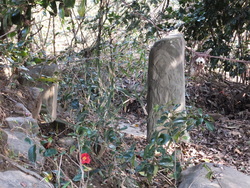|
There are over a hundred "kofun", ancient tombs and burial mounds, on Tsushima. Many of them are well preserved and easily accessible by car.
|
Sainoyama Burial Mound 【サイノヤマ古墳】

Located in Kechi, Mitsushima town (美津島町雞知)
A rectangular tomb with a tunneled stone hut. The mound was built in the early 7th century. There are several kofun (burial mounds) in Kechi and is said that the area used to be the center of the island.
A rectangular tomb with a tunneled stone hut. The mound was built in the early 7th century. There are several kofun (burial mounds) in Kechi and is said that the area used to be the center of the island.
Deizuka Burial Mound 【出居塚古墳】

Located in Kechi, Mitsushima town (美津島町雞知)
A keyhole-shaped burial mound with a pit stone hut. The mound was built in the late 4th century and is the biggest and the oldest tomb in Tsushima. It is also the only keyhole-shaped burial mound in Nagasaki prefecture. The tomb was robbed so there is not much left. There is a trail that connects to Sainoyama burial mound (see above).
A keyhole-shaped burial mound with a pit stone hut. The mound was built in the late 4th century and is the biggest and the oldest tomb in Tsushima. It is also the only keyhole-shaped burial mound in Nagasaki prefecture. The tomb was robbed so there is not much left. There is a trail that connects to Sainoyama burial mound (see above).
Neso Ancient Tombs 【根曽古墳群】

Located in Kechi, Mitsushima town (美津島町雞知)
There are five ancient tombs in the area. Three of them are keyhole shaped burial mounds and two are round burial mounds. They were built around the 5th ~ 6th centuries.
There are five ancient tombs in the area. Three of them are keyhole shaped burial mounds and two are round burial mounds. They were built around the 5th ~ 6th centuries.
Yatateyama Burial Mounds 【矢立山古墳】

Located in Shimobaru, Izuhara town (厳原町下原)
Three burial mounds are located in the area. No.1 and no.2 kofun have a tunneled stone hut. It is said they were built around the late 7th century.
Three burial mounds are located in the area. No.1 and no.2 kofun have a tunneled stone hut. It is said they were built around the late 7th century.
Karasaki Ancient Tomb 【唐崎遺跡】

Located in Saho, Toyotama town (豊玉町佐保)
The area used to be a small bay and a box-style stone casket was found on the point of the former cape. The stone casket from the Yayoi period (300 BC - 300 AD) still remain in the area.
The area used to be a small bay and a box-style stone casket was found on the point of the former cape. The stone casket from the Yayoi period (300 BC - 300 AD) still remain in the area.
Daishogun-Yama Burial Mound 【大将軍山古墳】

Located in Shitaru, Kamiagata town (上県町志多留)
The area used to have a shrine. A stone casket was excavated in 1950. Artifacts such as a mirror, pottery, and glass beads were found.
The area used to have a shrine. A stone casket was excavated in 1950. Artifacts such as a mirror, pottery, and glass beads were found.
To-no-kubi Burial Mound 【塔の首遺跡】

Located in Furusato, Kamitsushima town (上対馬町古里)
An ancient burial mound consisting of four box-shaped stone coffins. From the inside and outside of these stone coffins, artifacts such as stone accessories, bronze mirrors, and bronze spears were excavated. Because many bronze wares were excavated from box-shaped stone coffins in Tsushima, it is called the "bronze ware kingdom." This burial mound was found in 1971 by an elementary school student. It is designated as a national treasure and draws attention as it illustrates Tsushima's interchange with Korea in ancient times.
An ancient burial mound consisting of four box-shaped stone coffins. From the inside and outside of these stone coffins, artifacts such as stone accessories, bronze mirrors, and bronze spears were excavated. Because many bronze wares were excavated from box-shaped stone coffins in Tsushima, it is called the "bronze ware kingdom." This burial mound was found in 1971 by an elementary school student. It is designated as a national treasure and draws attention as it illustrates Tsushima's interchange with Korea in ancient times.
Asahiyama Burial Mound 【朝日山古墳】

Located in Hamagusu, Kamitsushima town (上対馬町浜久須)
Within the inlet of Hamagusu, a cape juts out eastward where Hekireki (Thunderclap) shrine is quieted. On the mountain behind it, rare artifacts such as Han Dynasty mirrors, iron swords, single-edged swords, axes, hoes, and unglazed pottery were found in several foundations of ancient tombs. Important to scholars, the ruins distinguish a middle period separate from the early and latter periods of ancient culture.
Within the inlet of Hamagusu, a cape juts out eastward where Hekireki (Thunderclap) shrine is quieted. On the mountain behind it, rare artifacts such as Han Dynasty mirrors, iron swords, single-edged swords, axes, hoes, and unglazed pottery were found in several foundations of ancient tombs. Important to scholars, the ruins distinguish a middle period separate from the early and latter periods of ancient culture.
Kofunosae Ruins 【コフノサエ遺跡】

Located in Tsuwa, Kamitsushima town (上対馬町津和)
Several stone caskets, built around 5th~7th centuries, were found in this area. Artifacts such as Japanese and Korean potteries were excavated, showing that Tsushima has had cultural exchange with Korea since ancient times.
Several stone caskets, built around 5th~7th centuries, were found in this area. Artifacts such as Japanese and Korean potteries were excavated, showing that Tsushima has had cultural exchange with Korea since ancient times.
Hotokoyama Burial Mound 【保床山古墳】

Located in Tsutsu, Izuhara town (厳原町豆酘)
The tomb is said to be built around late 7 century. There is not much left but there is a sign indicating where the tomb is located.
The tomb is said to be built around late 7 century. There is not much left but there is a sign indicating where the tomb is located.

